Occasionally you come across a place where you can see a labour of love has happened. Many years ago the RSPB Mersehead Reserve had accessible wildlife garden.
It was not a showy or pristine place. Functionality ruled. However there were subtle touches here and then which showed knowledge, commitment and interest. It turns out that Ella McLellan, RSPB Education Officer at the time used to be a professional wildlife gardener. She very kindly wrote parts of this post with lots of useful advice for schools.
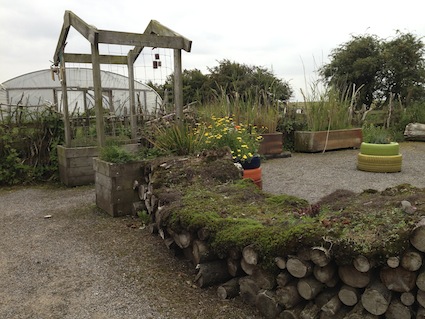
The reserve was bought by the RSPB in 1993 and the ‘field teaching’ service was launched in 2003. Due to a commitment within the RSPB to foster learning for all, the farmhouse was converted into The Sulwath Centre ( A centre for lifelong learning) in 2009. This combines a classroom, reception room, conference room, accommodation for residential volunteers and RSPB staff office. As part of this redevelopment it was felt that the grounds around the centre should also become flexible learning spaces for use by everyone.
We wanted also to show what could be achieved easily by schools with little money, time or space. Therefore we aimed not to create some luxury ‘designer’ garden but rather one which was easy, cheap, accessible for all, and flexible in its use. We also wanted the garden to able to be changed and adapted as we started to ‘get a feel’ for it and how children used it.
What particularly interests you about wildlife gardening?
I think what really interests me is how people and the environment mix. To me a good wildlife garden is a place people can live in as well as wildlife. You truly appreciate and love the wildlife around you when you see it, hear it, smell it, live with it and nurture it on a regular basis. Wildlife gardening has the ability to connect people to nature in very personal way. Gardening for wildlife just for the sake of it, without the personal connection is missing something to me. Sadly this is something you often see in schools. A bird box placed where no children can see it, a minibeasts habitat that is ‘off limits’, flowers that you can’t pick or a bird table which is never used.
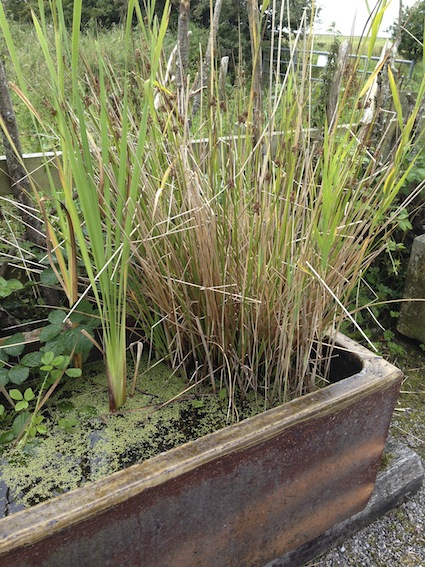
I sometimes give talks about wildlife gardening to social groups and I always begin with the question ‘What is a wildlife garden’. Most people think that it is an overgrown jungle of a place, with nettles and brambles everywhere, messy and unkempt. I then show a slide of my grandmothers back garden, which is a tiny piece of short clipped lawn with a single bird table in the middle. She feeds the birds here every day and gets so much pleasure from this simple place. She knows every bird by name, watches them raise their families, bemoans the neighbour’s cats that pass by, knows which food each bird likes and feel part of the greater world around her. To me this is just as valuable as the ‘jungle garden’ especially if no one ever goes out and enjoys it.
You should garden because you enjoy it, because being outside enriches your life, makes you happy, healthy or helps you relax. You should welcome wildlife to your garden as part of this, because a garden full of wildlife is an even more wonderful place to be.
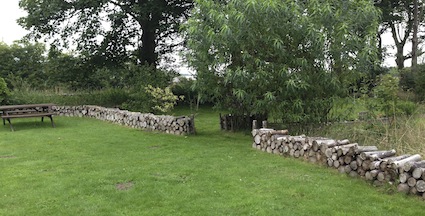
Where you get ideas and inspiration?
Other peoples gardens, school grounds, plant shows, blogs, magazines and now Pinterest. For example, the log wall was something I had seen at the Chelsea flower show years ago but without the turfs. The turf idea came from a lady who has a wildlife garden near Dalry where I was doing a moth trap event for the Scottish Wildlife Trust. When I visit places I try to take a camera with me and capture ideas with it.
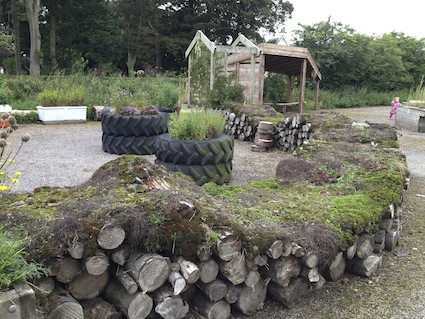
I also used to run a gardening club at the local primary school and this gave me an insight into the things that work and don’t work in a school environment. We also make a point of listening to the children who use our gardens and grounds and we adapt it to their ideas. This is how the den came to being, children wanted more hide away places within the grounds, so our teenage ‘Phoenix’ group created a den from branches and camouflage netting for kids to use.
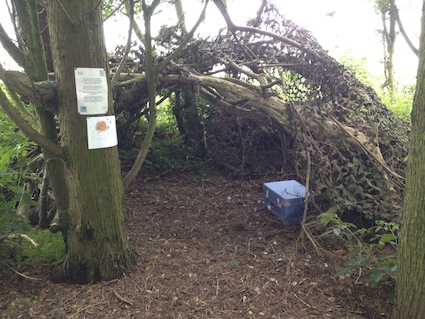
Any top tips for schools?
- Let children have ownership and use of the garden, make it ‘hands on’ all the time not just for ‘nature lessons’. Have things to pick and smell and move and touch.
- Plant blues and purples (loved by bees and butterflies) and yellows and whites (hoverflies and moths). As a general rule avoid red flowers as these are not as attractive to wildlife
- Choose single flowers (with one ring of petals) not double (with clusters of petals) as pollinators can’t reach the centre of the double flowers.
- Let there be pests! Aphids bring in ladybirds, caterpillars bring in blue tits, snails bring in song thrushes. A good ecosystem has pests as part of it. If your plants are healthy and strong they will generally be ok, nature will balance itself out and pests are cool for kids to look at too
- Grow simple things with the children, sunflowers (short varieties like Little Dorrit), nasturtiums, calendula (single varieties)
- Put things where they can be seen from the classroom windows, even just looking at nature has been shown to be very beneficial to people (Dr Marc Berman 2011, Roger Ulrich 1984 and 2003, Judith Heerwagen 1994)
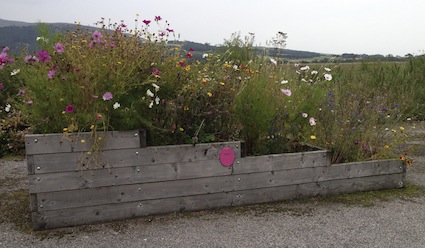
What immediately struck me was that everything was at an accessible height for wheelchair users. Do you see the terraced raised bed in the above photo? This means you can look at and touch the flowers at a height which suits you – whether you are a toddler or a two-metre giant!
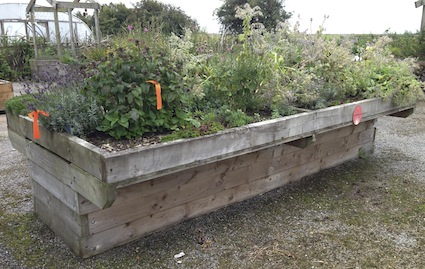
In the photo above, do you notice the orange tags attached to some of the plants in the herb bed? Everything with a tag is okay to pick and they smell or feel good…
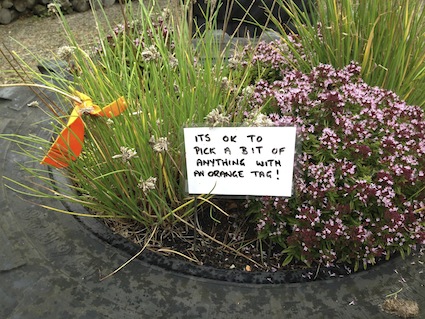
The minibeast area was really attractive. Look at the logs and branches. “We had a toad arrive almost immediately it was created. I was moving something that wasn’t quite right and there he was sitting happily in the base of the habitat. We have many varieties of ladybirds on site and I am sure they will be using this. Hopefully solitary bees like the red mason bee will use it next year too. There are the usual slaters, ground beetles, slugs and snails, millipedes, etc.“
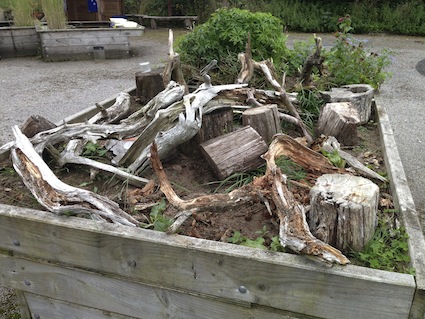
A raised pond was a key feature, with nets and a viewing platform included. Passing visitors can have a look without needing permission. “The raised ponds have been incredibly useful for wildlife and people, especially when the main wetlands dried up this summer due to the hot weather. Both this and the trough allows us to bring the wetlands and reed bed closer as it is very inaccessible on the reserve and the reeds make a great sound in the wind.”
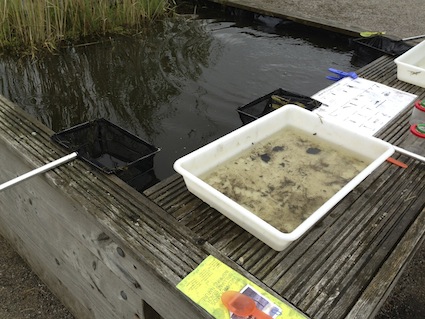
There was also a sand play area. I liked that the liner had been left to overlap the edges. “If there was a quick shower of rain we could cover the sand and keep it dry without having to put the large overnight lids on. We intend to cover the sides with stuck on cockle shells at some point in the future.” The layout is sociable with children being able to see each other. Also, have a look at the fencing in the background. The sea theme is continued with the life ring and fishing net. I also liked the addition of sticks around the fencing area.
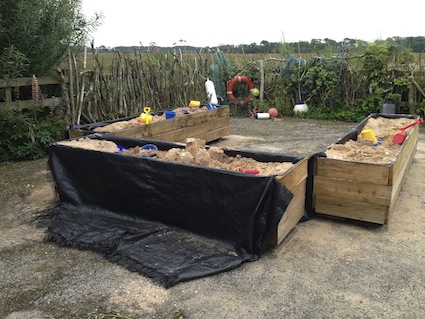
This sort of garden is not simply useful for those who work with children and young people with additional support needs. Because the ground is flat and featureless, these ideas are very transferable to those who work in school with just tarmac outdoor spaces. If you can’t dig down, just put boxes on top.
Finally, this was that this was not the only garden available for visitors. The bird garden was one of the nicest I’ve ever seen. That’s for another blog post…
Please note: Ella has since moved on from this RSPB reserve and the wildlife garden has changed quite a bit with much of it no longer present as when this blog post was originally written in August 2013. However her ideas and advice remain very useful.




















Love this, such a practical post, going to pass on to our gardening club teachers
So many great ideas, love the den and the quick sand covering. Thanks for stopping by the Outdoor Play Party
What a great post! My 4 year old has just sat next to me looking, going ‘WOW! Can we get that in OUR garden?!’ to every picture! Some excellent ideas 🙂 xx